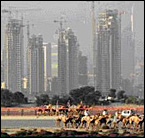Water & Wastewater Market Brief Saudi Arabia
 The water sector in Saudi Arabia holds great potential for development and growth. Industry sources expect that more than $200 billion will be invested over the next 20 years on water and power projects, especially in water treatment plants, sewage plants, & desalinization projects.
The water sector in Saudi Arabia holds great potential for development and growth. Industry sources expect that more than $200 billion will be invested over the next 20 years on water and power projects, especially in water treatment plants, sewage plants, & desalinization projects.
Saudi Arabia consumes over 22 billion cubic meters of water annually, having the highest per capita water consumption rates in the world, and the country is expected to face extreme water shortages. The total volumes of available renewable water resources from surface water and groundwater recharge are about 6,188 metric M³. To meet the growing demand for water, the Saudi Government is re-organizing the water sector, launching water conservation campaigns and encouraging the private sector to take the lead in establishing and managing water purification and desalination plants.
A major development took place in 2003 with the creation of Water & Electricity Company (WEC) to carry out the independent water and power projects. Likewise, the Saudi Government has taken significant steps to improve the water sector’s regulatory framework and pave the way for the sector’s privatization, especially in power and water desalination projects.
Market Demand
There is an urgent need to increase water and power capacity in order to keep up with a growing population and urbanization trend. With a population reaching more than 27 million in 2007 and growing at an average annual rate of 2.2 percent, the government faces a major challenge in meeting the water needs of its burgeoning population over the next 20 years. Huge capital investment is needed over the next 15 years to supply the present and future demand for water services. The Saudi government is in the process of evaluating alternative approaches to privatizing water sector, which is heavily subsidized at present. Demand for water in Saudi Arabia is expected to increase from 6 million cubic meters per day in 2004 to 7.2 million cubic meters per day in 2010, and up to 9.6 million cubic meters per day ten years later. Industry sources expect desalination to remain a major industry in Saudi Arabia for quite some time.
Market Data & Best Prospects
The Kingdom of Saudi Arabia relies heavily on water desalination for its fresh water and is the world largest producer of desalinated water in the world, with a production capacity of 3.6 million cubic meters per day. The Kingdom established 30 desalination plants on the Red Sea and Arabian Gulf coast, which produce 3.6 million M³ of water per day. This production meets approximately 60 percent of Saudi Arabia’s demand for drinking water.
Saudi Arabia’s food security policy has implied a high allocation of water resources to the agriculture sector. In 2003, the Kingdom’s agricultural sector accounted for 88 percent of overall water consumption. At the time, the Saudi Government fully supported the costs of water and sanitation services in the Kingdom. Industry sources estimate that Saudi Arabia will require investments in water projects of about $130 billion to satisfy the country’s growing need for water and sanitation services up to 2022, about 40 percent of that investment will be spent on expanding the desalination capacity to 9.6 million cubic meters per day by 2020.
In 2007, the Saudi Government allocated $4.37 billion for water, sewage, and desalination projects, 25 percent more than in the 2006 government budget. As part of its privatization drive, the Saudi Government is reassessing water tariffs and is developing a national water plan to encourage foreign investments in water projects. The Saline Water Conversion Corporation (SWCC) has signed contracts with legal, strategic, financial, and technical advisers to develop a comprehensive plan for the privatization of the state-owned water company with a deadline for completion as early as 2008. The SWCC already manages 30 plants, 24 on the Red Sea and six on the Persian Gulf, with a total production capacity of 3.6 million M³ of water per day and plans to build or expand 11 desalination plants with an additional 362,000 M³ of water per day.
Likewise, private investment in the water sector took a leap forward with a number of IWPPs in the production/development stage, including:
Additionally, the Water & Electricity Utility Company, MARAFIQ, is building a combined cycle gas turbine plant on a BOOT basis in Jubail. Once commissioned in 2009, the plant will produce 800,000 M³ of water per day and 2,746 MW of electricity. The MARAFIQ’s IWPP will entail investments of $3.36 billion.
Apart from increasing its water resources, the Saudi Government also is focusing its efforts on water management, including additional investment in wastewater treatment facilities, monitoring and fixing leakages in the national water system, educating users about efficient water usage, and expanding the Kingdom’s network of dams. The Ministry of Water and Electricity estimates a total investment of $10.7 billion will be required to build new water purification stations and/or to upgrade existing facilities, especially in urban areas such as Riyadh, Jeddah, Dammam/Al-Khobar/Dhahran.
Opportunities
The water sector in Saudi Arabia is bound for huge investments and growth. The Saudi government has already committed to build a number of desalination plants as well as to open up the sector to private investors. As previously indicated, the following are the major projects in the water sector:
Extracts from Water & Wastewater Market Brief Saudi Arabia, The U.S. Commercial Service, May, 2007.
You can return to the main Market News page, or press the Back button on your browser.

